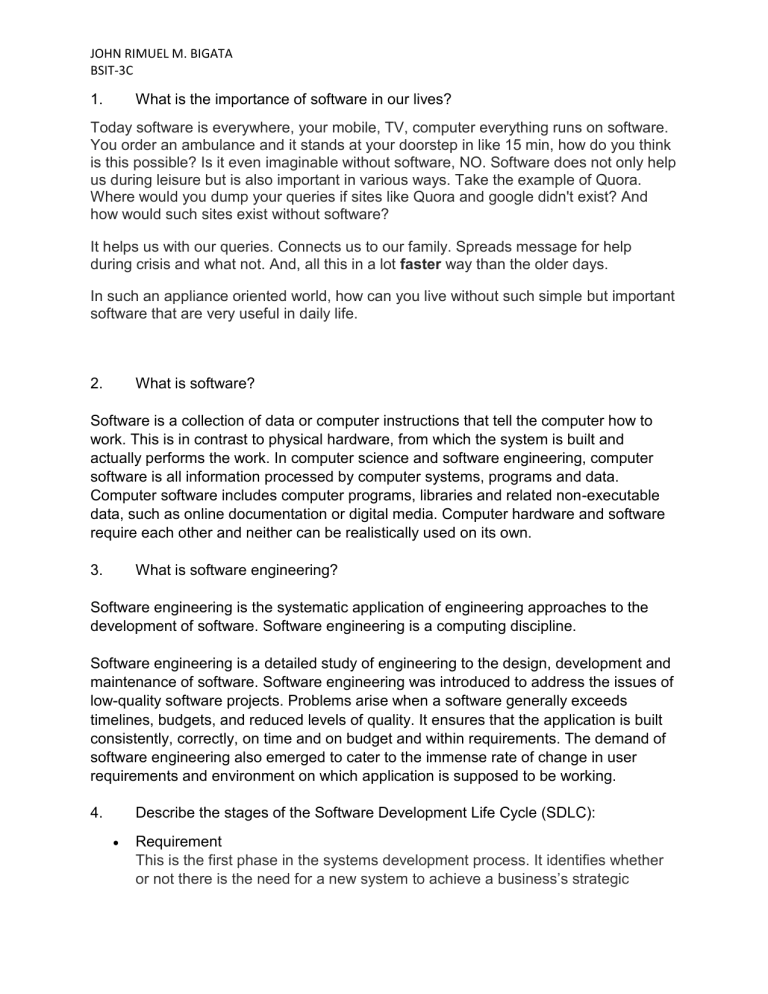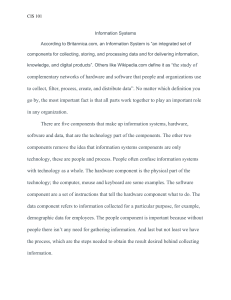
JOHN RIMUEL M. BIGATA BSIT-3C 1. What is the importance of software in our lives? Today software is everywhere, your mobile, TV, computer everything runs on software. You order an ambulance and it stands at your doorstep in like 15 min, how do you think is this possible? Is it even imaginable without software, NO. Software does not only help us during leisure but is also important in various ways. Take the example of Quora. Where would you dump your queries if sites like Quora and google didn't exist? And how would such sites exist without software? It helps us with our queries. Connects us to our family. Spreads message for help during crisis and what not. And, all this in a lot faster way than the older days. In such an appliance oriented world, how can you live without such simple but important software that are very useful in daily life. 2. What is software? Software is a collection of data or computer instructions that tell the computer how to work. This is in contrast to physical hardware, from which the system is built and actually performs the work. In computer science and software engineering, computer software is all information processed by computer systems, programs and data. Computer software includes computer programs, libraries and related non-executable data, such as online documentation or digital media. Computer hardware and software require each other and neither can be realistically used on its own. 3. What is software engineering? Software engineering is the systematic application of engineering approaches to the development of software. Software engineering is a computing discipline. Software engineering is a detailed study of engineering to the design, development and maintenance of software. Software engineering was introduced to address the issues of low-quality software projects. Problems arise when a software generally exceeds timelines, budgets, and reduced levels of quality. It ensures that the application is built consistently, correctly, on time and on budget and within requirements. The demand of software engineering also emerged to cater to the immense rate of change in user requirements and environment on which application is supposed to be working. 4. Describe the stages of the Software Development Life Cycle (SDLC): Requirement This is the first phase in the systems development process. It identifies whether or not there is the need for a new system to achieve a business’s strategic JOHN RIMUEL M. BIGATA BSIT-3C objectives. This is a preliminary plan (or a feasibility study) for a company’s business initiative to acquire the resources to build on an infrastructure to modify or improve a service. The company might be trying to meet or exceed expectations for their employees, customers and stakeholders too. The purpose of this step is to find out the scope of the problem and determine solutions. Resources, costs, time, benefits and other items should be considered at this stage. Analysis The second phase is where businesses will work on the source of their problem or the need for a change. In the event of a problem, possible solutions are submitted and analyzed to identify the best fit for the ultimate goal(s) of the project. This is where teams consider the functional requirements of the project or solution. It is also where system analysis takes place—or analyzing the needs of the end users to ensure the new system can meet their expectations. Systems analysis is vital in determining what a business’s needs are, as well as how they can be met, who will be responsible for individual pieces of the project, and what sort of timeline should be expected. Design The third phase describes, in detail, the necessary specifications, features and operations that will satisfy the functional requirements of the proposed system which will be in place. This is the step for end users to discuss and determine their specific business information needs for the proposed system. It"s during this phase that they will consider the essential components (hardware and/or software) structure (networking capabilities), processing and procedures for the system to accomplish its objectives. Implementation This is when the majority of the code for the program is written. Additionally, this phase involves the actual installation of the newly-developed system. This step puts the project into production by moving the data and components from the old system and placing them in the new system via a direct cutover. While this can be a risky (and complicated) move, the cutover typically happens during off-peak hours, thus minimizing the risk. Both system analysts and end-users should now see the realization of the project that has implemented changes. Testing Involves systems integration and system testing (of programs and procedures)— normally carried out by a Quality Assurance (QA) professional—to determine if the proposed design meets the initial set of business goals. Testing may be repeated, specifically to check for errors, bugs and interoperability. This testing will be performed until the end user finds it acceptable. Another part of this phase is verification and validation, both of which will help ensure the program’s successful completion. JOHN RIMUEL M. BIGATA BSIT-3C References: Kashyap, S. (2017, February 26). What is the importance of software in daily life? Quora. https://www.quora.com/What-is-the-importance-of-software-in-dailylife/answer/Shubham-Kashyap-134 Wikipedia contributors. (2020, November 28). Software. Wikipedia. https://en.wikipedia.org/wiki/Software Wikipedia contributors. (2020b, December 12). Software engineering. Wikipedia. https://en.wikipedia.org/wiki/Software_engineering Economic Times. (n.d.). What is Software Engineering? Definition of Software Engineering, Software Engineering Meaning. The Economic Times. Retrieved December 15, 2020, from https://economictimes.indiatimes.com/definition/software-engineering SDLC: Seven Phases of the System Development Life Cycle. (n.d.). Innovativearchitects. Retrieved December 15, 2020, from https://www.innovativearchitects.com/KnowledgeCenter/basic-IT-systems/systemdevelopment-life-cycle.aspx









